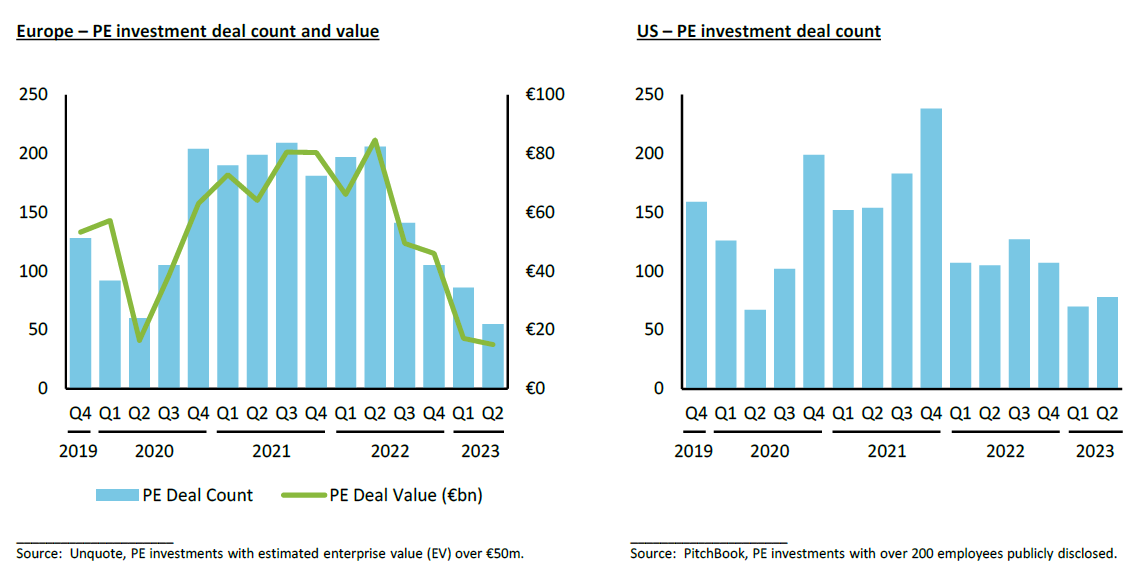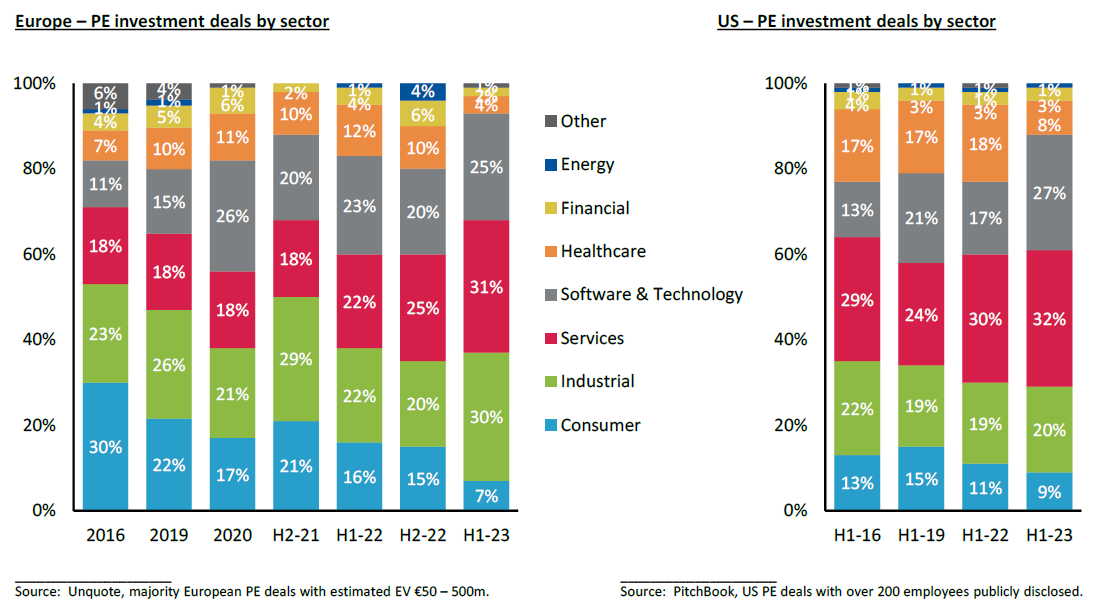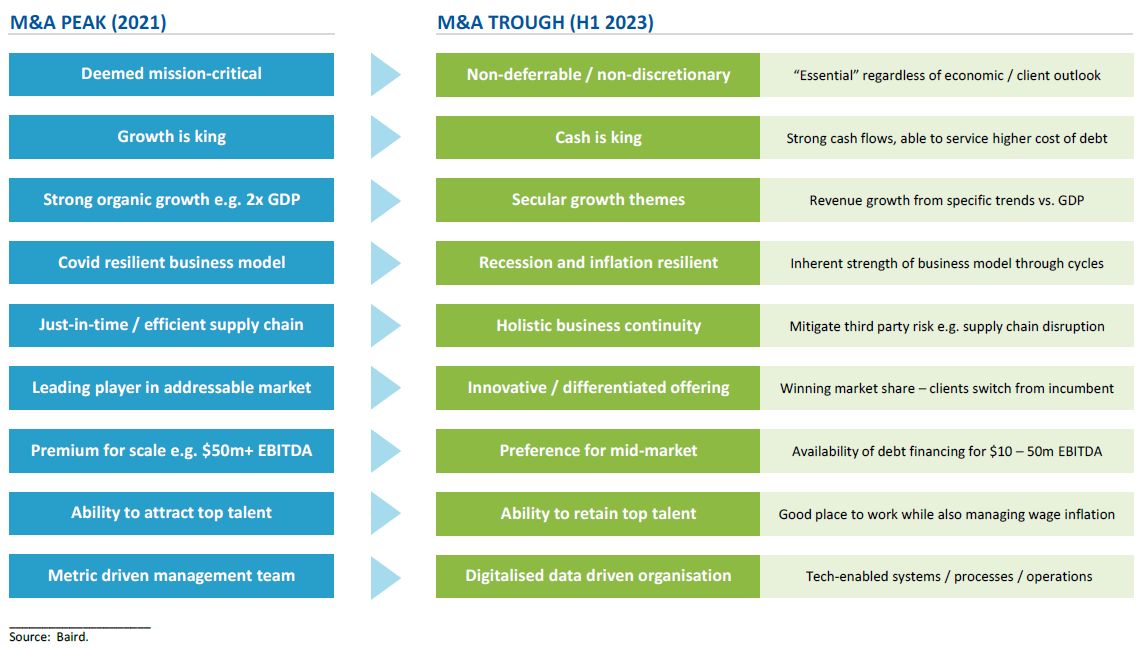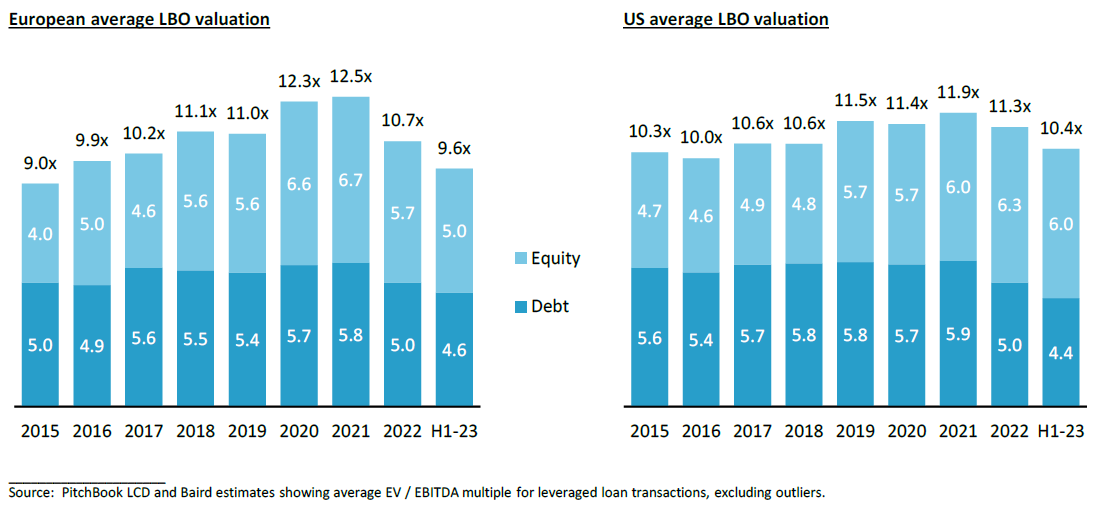
Which sectors are private equity investing in at the trough of this M&A cycle?
A review of H1 2023 PE M&A activity by sector in Europe and the U.S.
The first half (H1) of 2023 saw low levels of private equity (PE) investment, similar to the muted activity levels of the Covid lockdown in Q2 2020. We are likely at the trough of this M&A cycle, and we have outlined our view on the potential for the global M&A market to strengthen in H2 2023 and 2024 in our mid-year M&A outlook.
PE firms are scrutinising business models, end markets and the quality of EBITDA, focused on acquiring resilient assets given the recessionary environment and the substantially higher cost of debt that needs strong and predictable cash flows to finance. For this article, we conducted a deal-by-deal analysis of sector trends and business model characteristics for PE deployment in Europe and the US, to see where and how PE firms invested in H1 2023.

The mix of PE activity by sector in H1 2023 is unique
For the first time, the combined share of the Services and Software & Technology sectors accounted for the majority of PE investment activity by deal count in H1 2023, at over 55% in both Europe and the US. Also for the first time, Consumer contributed its lowest share of PE activity at less than 10%, a stark contrast to its leading position of 30% in Europe in 2016. Despite being a highly resilient sector, Healthcare activity was also at a record low, accounting for less than half of its usual share in both regions. The Industrial sector maintained its share of 20% of PE activity in the US while reaching a record high of 30% in Europe. We discuss the drivers behind a few of these market trends below.

Evolution of attractive company / business model characteristics
Private equity has evolved its views on “what good looks like” since the peak of the M&A market in 2021. We have observed that the following business model characteristics have attracted significant attention from PE firms operating across different sectors over the last 12 months. Potential lenders have often asked for the target company’s financial performance during the Great Financial Crisis in 2008 and 2009, even if the business itself has changed considerably.

Decrease in expected M&A valuation is not uniform across sectors
Average M&A valuation levels are lower in H1 2023 compared to the peak of this M&A cycle in 2021. However, the quantum of the fall depends on each individual company, and is therefore different across sectors and subsectors. A substantial number of buyers and sellers of Industrial and Services companies are managing to sign M&A transactions with valuation multiples ~2x EBITDA or ~15% lower (e.g. 12x instead of 14x EBITDA) than what likely could have been achieved in 2021. However, some owners of Healthcare companies might not be launching sale processes in today’s M&A market as valuation multiples could be up to ~25% lower (e.g. 15x instead of 20x EBITDA) than the peak.

We continue to see strong PE valuation levels in 2023 for the highest quality assets with inflation-resilient business models, strong current trading and well-supported financial forecasts. However, we have also seen cash-rich strategic buyers step up to take advantage of “trade-only M&A processes” or lower valuations put forward by PE bidders who are constrained by today’s 10%+ LBO financing costs. The mix of PE investment activity by sector has been impacted by a decrease in expected M&A valuation and strategic buyers taking back a meaningful share of the global M&A market.
Consumer – PE appetite for non-discretionary and certain “premium” categories with secular tailwinds
Global supply chain disruption from Covid drove high international shipping container costs in 2021, impacting certain Consumer subsectors. As the supply chain started to normalise in mid-2022, macroeconomic uncertainty and the decline in real incomes from inflation impacted consumer sentiment. Despite this, retail spending held up, particularly in the US where savings during Covid continued to be spent ($2tn of excess savings for American households in 2021) over the last 12 months. However, US consumers have now largely spent those excess savings, increasing the likelihood of a recession in the next 12 months. Some European countries experienced a technical recession in early 2023 while the UK continues to struggle with high inflation despite base rate increases by the Bank of England.
Furthermore, there has been a shift in consumer spending away from products and towards services and experiences. The post-Covid recovery of subsectors such as Travel, Leisure & Hospitality has been strong, but not evenly spread. With this macro backdrop, the Consumer sector has seen the greatest divergence between the secular growth driven “winners” and the more cyclically exposed “losers”, which has notably lowered the velocity of Consumer M&A activity.
Several generalist / multi-sector PE firms and lenders are shying away from new Consumer investments, only evaluating such opportunities on a “by exception” basis. PE firms with an active Consumer focus are benefitting from this dynamic, able to differentiate themselves when building relationships with target companies. Consumer focused PE firms are increasingly acquiring companies with non-discretionary products or recurring revenue streams, which typically benefit from less cyclicality and lower elasticity of demand. For example, the “impulse” category has a track record of resilient financial performance given its low price point of semi-consumable products (average of $2).
We see strong mid-market investor attention on subsectors, such as Food & Beverage, Health, Pet and Juvenile, that benefit from secular tailwinds, consolidation / roll-up potential and in many cases international brand stories. The recessionary environment has also heightened investment appetite for certain “premium” segments that are considered “must-have”. As such, the premium / indulgence segment of Food & Beverage was the most active subsector for Consumer PE deals in both Europe and the US in H1 2023.
Industrial – secular growth themes not dependent on the general industrial cycle
2022 represented the peak of this general Industrial cycle, where order backlogs were at their highest for many large publicly listed corporates. New orders for these corporates have since started to fall in H1 2023 with the Manufacturing PMI (Purchasing Managers Index) now below 50 (representing contraction) across North America, Europe and China. As global supply chains have largely normalised, Industrial companies across various subsectors are operating with higher profit margins as they convert order backlog into revenue throughout 2023. With significant cash built up on balance sheets and lower competition from private equity, certain Industrial corporates have taken the opportunity to make highly synergistic mid-market and multi-billion dollar acquisitions over the last 12 months.
Having said this, mid-market PE Industrial M&A activity is recovering, particularly for companies supported by secular growth themes such as automation, electrification, safety and Internet of Things that help customers be more efficient, productive and connected (data-enabled) – electrification, including modernisation of the grid, is backed by long term US and European Commission investment plans. Such themes can drive strong organic revenue growth for Industrial companies, even during periods of flat or negative growth in the broader economy. Examples of high growth Industrial applications include e-commerce warehouse automation, data centre cooling and packaging material testing. As such, PE deals in H1 2023 were seen across many Industrial subsectors, including Building Technology, Distribution, Flow Technologies, Renewable Energy, Specialty Materials, Test & Measurement and Thermal Management.
Services – long term contracts for non-discretionary solutions
Services represented over 30% of PE activity in Europe and the US, making it the most active sector. B2B clients are typically more reluctant to sign new service contracts in a recessionary environment, but are also unwilling to cut non-discretionary solutions when contracts are up for renewal. High customer retention / renewal rates underpin the defensive business model of many Services companies. Buy-and-build platforms are often able to grow during economic downturns as they benefit from cross-selling synergies with existing and new clients (“land and expand”).
FIRE (facility, industrial, rental and environmental) was the most active subsector within Services in H1 2023. It covers a vast array of non-deferrable services, all of which are performed onsite and necessary for the clients’ daily operations. PE firms are attracted to multi-year customer contracts and accretive roll-up strategies given the number of “mom & pop shops” in highly fragmented FIRE markets. Sale processes for best-in-class FIRE assets continue to be launched and Baird-tracked metrics show indicative bid valuation levels are higher than the average over the last 5 years.
Other Services subsectors where private equity has invested during the trough of this M&A cycle include:
- BPO – outsourcing is in the early innings in many segments where the majority of work is still conducted in-house e.g. knowledge process outsourcing, recruitment process outsourcing, enterprise labelling management, etc.
- Education – early education and K-12 private schools that have recovered child / student volumes post-Covid benefit from recession-resistant demand, expanding profitability (high incremental margins) and strong cash flow.
- Government Services – stable underlying demand through economic cycles is highly attractive, with additional growth drivers including digital transformation and cyber solutions for the US national security community.
Software & Technology – recovering valuations for highly cash generative companies
Financial metrics for publicly listed Technology companies have softened from their highs in 2021 given the challenging macro backdrop, ongoing cloud optimisation and elongated sales cycles. However, Technology stocks made a partial recovery with the Nasdaq increasing over 30% in H1 2023. Strategic buyers have increased their share of Technology M&A, particularly for high growth targets that are not yet profitable. With a quiet IPO market over the last 12 months, some VC-backed companies are selling to strategic buyers (instead of private equity) to survive a funding crunch.
Nonetheless, Software & Technology represented over 25% of PE activity across Europe and the US, making it the second most active sector. Despite the higher cost of debt financing, LBO valuations in the Software & Technology sector are recovering in recent months. Private equity appetite for highly cash generative software companies remains strong post Covid, particularly for vertical software (dedicated end market) where go-to-market efficiency (revenue generated for each dollar spent on sales & marketing) is typically higher than horizontal software. For example, there were a handful of secondary buyouts across Europe and the US for Education software businesses in H1 2023, where their solutions were purpose-built for the unique requirements of the respective domestic K-12 school market.
A high proportion of horizontal software deals were in subsectors driven by secular growth themes such as AI (artificial intelligence), Cybersecurity and GRC (governance, risk & compliance). We also saw PE firms acquire Information providers that increasingly use software to deliver data solutions and operate with best-in-class SaaS-like growth and margin metrics. As such, PE firms are sometimes paying “peak” valuation multiples e.g. 8x+ revenue, 20x+ EBITDA.
Healthcare – resilient sector still emerging from a Covid demand and supply chain hangover
The share of PE investment activity in Healthcare in recent years has been similar to healthcare’s proportion of regional GDP at 10% in Europe and 20% in the US. However, H1 2023 has seen its contribution halve due to various factors:
- Healthcare continues to emerge from a Covid demand and supply chain hangover, clouding agreement on sustainable revenue and growth trends – targets therefore need time to show a “clean” period of financial data.
- High seller valuation expectations and little urgency to come to market with well performing best-in-class assets, many of which were acquired at the peak of the M&A market in 2021 so are relatively young in PE firms’ portfolios.
- Tight labour market impacting operational and financial performance of some Healthcare subsectors.
- Healthcare ECM (equity capital markets) is at low point with many companies from the IPO class of 2019 – 2021 inward focused vs. spending on M&A i.e. preserving liquidity and not motivated to use equity as consideration.
- Increasing antitrust sentiment from the US FTC (Federal Trade Commission), which is aggressively scrutinising strategic multi-billion dollar Healthcare M&A deals, resulting in lawsuits e.g. $28bn Amgen / Horizon deal.
These specific issues, impacting the appetite of both financial and strategic buyers, have persuaded potential vendors to hold onto their Healthcare assets in the short term. To facilitate capital return to various investors, we have seen a number of GP-led secondary deals (e.g. continuation vehicles) in H1 2023, particularly in the Healthcare Services subsector. Longer term, the combination of secular growth themes and defensive characteristics will keep PE firms and lenders attracted to the broader Healthcare sector. With a lack of significant regulatory headwinds in the US, there is a possibility that Healthcare M&A deal velocity in 2024 could see a similar uptick to 2021.
M&A outlook – accelerating wave of PE exits and investments may come in 2024
Based on an upcoming peak in the level of base interest rates and positive client discussions on our current M&A mandates, we expect to come out of the trough in PE M&A activity in H2 2023. Factors driving a recovery include:
- Pent-up supply and demand. The M&A backlog continues to build as vendors closely monitor market trends to determine sale process launch timing. The majority of PE portfolio companies have been held for over 4 years, a figure set to be 5 years in 2024 unless we see an accelerating wave of PE exits. The M&A market is open and private equity is generally in deployment mode given the wall of dry powder, currently sitting at over $2tn globally.
- LPs (limited partners) are becoming more reliant on distributions to fund capital calls. GPs (general partners) will be under pressure to exit certain portfolio companies sooner rather than later. Prioritising liquidity over higher returns may also help to further narrow the valuation gap between sellers and buyers in today’s M&A market.
- More realistic valuation expectations. Vendors across the ecosystem (founders, corporates, private equity, etc.) are accepting lower valuation multiples, especially where EBITDA has grown substantially and far outweighs the impact on enterprise value from a lower multiple. This makes M&A deal signings more achievable, including for assets with recession risk that attract fewer indicative offers and are more susceptible to valuation headwinds.
- Portfolio reviews, exiting assets where the projected return profile is now lower. A PE portfolio company halfway through executing a buy-and-build strategy might not generate its projected return on future add-on acquisitions given the increased cost of acquisition debt – preparing the company for sale now might be the best option.
- Strong PE appetite, searching for the next cohort of investments. The sponsor community is actively building up its pipeline of targets. We saw record engagement at our Consumer and Technology & Services conferences and strategy forum in June 2023 and have similar attendance for our upcoming Healthcare and Industrial conferences.
Contact a member of Baird’s Financial Sponsors Group or Global M&A team to discuss in further detail.